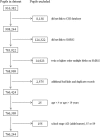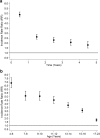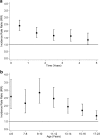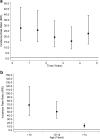Educational and health outcomes of children and adolescents receiving antiepileptic medication: Scotland-wide record linkage study of 766 244 schoolchildren
- PMID: 31101093
- PMCID: PMC6525436
- DOI: 10.1186/s12889-019-6888-9
Educational and health outcomes of children and adolescents receiving antiepileptic medication: Scotland-wide record linkage study of 766 244 schoolchildren
Abstract
Background: Childhood epilepsy can adversely affect education and employment in addition to health. Previous studies are small or highly selective producing conflicting results. This retrospective cohort study aims to compare educational and health outcomes of children receiving antiepileptic medication versus peers.
Methods: Record linkage of Scotland-wide databases covering dispensed prescriptions, acute and psychiatric hospitalisations, maternity records, deaths, annual pupil census, school absences/exclusions, special educational needs, school examinations, and (un)employment provided data on 766,244 children attending Scottish schools between 2009 and 2013. Outcomes were adjusted for sociodemographic and maternity confounders and comorbid conditions.
Results: Compared with peers, children on antiepileptic medication were more likely to experience school absence (Incidence Rate Ratio [IRR] 1.43, 95% CI: 1.38, 1.48), special educational needs (Odds ratio [OR] 9.60, 95% CI: 9.02, 10.23), achieve the lowest level of attainment (OR 3.43, 95% CI: 2.74, 4.29) be unemployed (OR 1.82, 95% CI: 1.60, 2.07), be admitted to hospital (Hazard Ratio [HR] 3.56, 95% CI: 3.42, 3.70), and die (HR 22.02, 95% CI: 17.00, 28.53). Absenteeism partly explained poorer attainment and higher unemployment. Girls and younger children on antiepileptic medication had higher risk of poor outcomes.
Conclusions: Children on antiepileptic medication fare worse than peers across educational and health outcomes. In order to reduce school absenteeism and mitigate its effects, children with epilepsy should receive integrated care from a multidisciplinary team that spans education and healthcare.
Keywords: Educational outcomes; Epilepsy; Health; Population cohort; Prescribing; Record linkage.
Conflict of interest statement
All authors declare that they have no competing interests.
Figures




Similar articles
-
Educational and health outcomes of children and adolescents receiving antidepressant medication: Scotland-wide retrospective record linkage cohort study of 766 237 schoolchildren.Int J Epidemiol. 2020 Aug 1;49(4):1380-1391. doi: 10.1093/ije/dyaa002. Int J Epidemiol. 2020. PMID: 32073627 Free PMC article.
-
Educational and health outcomes of children treated for asthma: Scotland-wide record linkage study of 683 716 children.Eur Respir J. 2019 Sep 5;54(3):1802309. doi: 10.1183/13993003.02309-2018. Print 2019 Sep. Eur Respir J. 2019. PMID: 31196949 Free PMC article.
-
Educational and Health Outcomes of Children Treated for Attention-Deficit/Hyperactivity Disorder.JAMA Pediatr. 2017 Jul 3;171(7):e170691. doi: 10.1001/jamapediatrics.2017.0691. Epub 2017 Jul 3. JAMA Pediatr. 2017. PMID: 28459927 Free PMC article.
-
Rinse-free hand wash for reducing absenteeism among preschool and school children.Cochrane Database Syst Rev. 2020 Apr 9;4(4):CD012566. doi: 10.1002/14651858.CD012566.pub2. Cochrane Database Syst Rev. 2020. PMID: 32270476 Free PMC article.
-
[What support of young presenting a first psychotic episode, when schooling is being challenged?].Encephale. 2017 Dec;43(6):570-576. doi: 10.1016/j.encep.2017.10.001. Epub 2017 Nov 8. Encephale. 2017. PMID: 29128195 Review. French.
Cited by
-
From illness to inactivity: Exploring the influence of physical diseases on youth Not in Education, Employment, or Training status in Europe: A systematic literature review.J Adolesc. 2024 Dec;96(8):1695-1712. doi: 10.1002/jad.12386. Epub 2024 Aug 8. J Adolesc. 2024. PMID: 39118270 Free PMC article.
-
Schoolteacher's knowledge, attitudes, and practice toward student with epilepsy in Taif, Saudi Arabia: Cross-sectional study.J Family Med Prim Care. 2021 Jul;10(7):2668-2678. doi: 10.4103/jfmpc.jfmpc_2087_20. Epub 2021 Jul 30. J Family Med Prim Care. 2021. PMID: 34568153 Free PMC article.
-
Economic Evaluation of anti-epileptic Medicines for Autistic Children with Epilepsy.J Autism Dev Disord. 2024 Jul;54(7):2733-2741. doi: 10.1007/s10803-023-05941-8. Epub 2023 May 4. J Autism Dev Disord. 2024. PMID: 37142904 Free PMC article.
-
Educational and health outcomes of children and adolescents receiving antidepressant medication: Scotland-wide retrospective record linkage cohort study of 766 237 schoolchildren.Int J Epidemiol. 2020 Aug 1;49(4):1380-1391. doi: 10.1093/ije/dyaa002. Int J Epidemiol. 2020. PMID: 32073627 Free PMC article.
-
Academic competence and special educational needs as outcomes of early onset epilepsy: A population-based prospective follow-up study.Epilepsy Behav Rep. 2025 Apr 30;31:100777. doi: 10.1016/j.ebr.2025.100777. eCollection 2025 Sep. Epilepsy Behav Rep. 2025. PMID: 40469840 Free PMC article.
References
-
- Fisher RS, Acevedo C, Arzimanoglou A, et al. ILAE official report: a practical clinical definition of epilepsy. Epilepsia. 2014;55(4):475–482. - PubMed
-
- Joint Epilepsy Council. Epilepsy prevalence, incidence and other statistics. 2011. https://d3imrogdy81qei.cloudfront.net/instructor_docs/373/29_05_2016_Joi.... Accessed 03 May 2019.
-
- Berg AT, Jallon P, Preux PM. The epidemiology of seizure disorders in infancy and childhood: definitions and classifications. Handb clinical neurol. 2013;111:391–398. - PubMed
-
- Forsgren L, Beghi E, Oun A, Sillanpaa M. The epidemiology of epilepsy in Europe – a systematic review. Eur J Neurol. 2005;12:245–253. - PubMed
MeSH terms
Substances
Grants and funding
LinkOut - more resources
Full Text Sources
Medical

